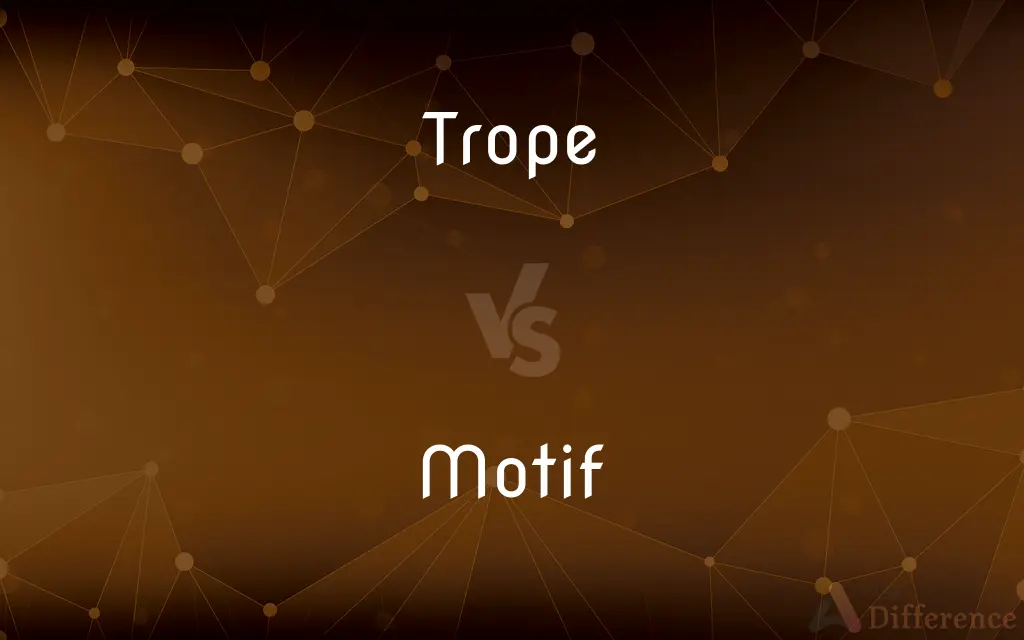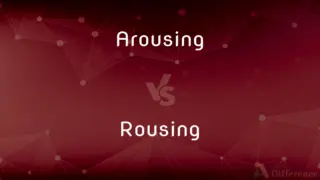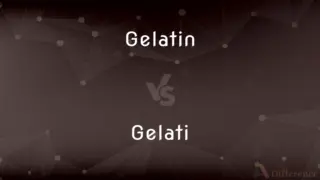Trope vs. Motif — What's the Difference?

Difference Between Trope and Motif
ADVERTISEMENT
Compare with Definitions
Trope
A figurative or metaphorical use of a word or expression
My sense that philosophy has become barren is a recurrent trope of modern philosophy
Perhaps it is a mistake to use tropes and parallels in this eminently unpoetic age
Both clothes and illness became tropes for new attitudes toward the self
Motif
A recurrent thematic element in an artistic or literary work.
Trope
A figure of speech using words in nonliteral ways, such as a metaphor.
Motif
A dominant theme or central idea.
Trope
A word or phrase interpolated as an embellishment in the sung parts of certain medieval liturgies.
ADVERTISEMENT
Motif
(Music) A short rhythmic or melodic passage that is repeated or evoked in various parts of a composition.
Trope
A theme, motif, plot, or literary device that commonly recurs within a genre or work of fiction, especially when considered clichéd
“Finding the corrosion under the waxed-and-polished chassis of small-town America is itself an old trope” (James Poniewozik).
Motif
A repeated figure or design in architecture or decoration.
Trope
An often recurring idea or image
“In our conversations, there was a running theme, a trope, of economic havoc, of drowned cities, of time running out” (Jon Gertner).
Motif
A recurrent pattern either of molecular sequence, usually of nucleotides or amino acids in proteins, or of molecular structure that usually corresponds to specific biological activity.
Trope
Something recurring across a genre or type of art or literature, such as the ‘mad scientist’ of horror movies or the use of the phrase ‘once upon a time’ as an introduction to fairy tales; a motif.
Motif
A recurring or dominant element; an artistic theme.
See how the artist repeats the scroll motif throughout the work?
Trope
(medieval Christianity) An addition (of dialogue, song, music, etc.) to a standard element of the liturgy, serving as an embellishment.
Motif
(music) A short melodic or lyrical passage that is repeated in several parts of a work.
Trope
(rhetoric) A figure of speech in which words or phrases are used with a nonliteral or figurative meaning, such as a metaphor.
Motif
A decorative figure that is repeated in a design or pattern.
Trope
(geometry) Mathematical senses.
Motif
(dressmaking) A decorative appliqué design or figure, as of lace or velvet, used in trimming.
Trope
A tangent space meeting a quartic surface in a conic.
Motif
(crystallography) The physical object or objects repeated at each point of a lattice. Usually atoms or molecules.
Trope
(archaic) The reciprocal of a node on a surface.
Motif
(chess) A basic element of a move in terms of why the piece moves and how it supports the fulfilment of a stipulation.
Trope
(music) Musical senses.
Motif
(biochemistry) In a nucleotide or aminoacid sequence, pattern that is widespread and has, or is conjectured to have, a biological significance.
Trope
A short cadence at the end of the melody in some early music.
Motif
Motive.
Trope
A pair of complementary hexachords in twelve-tone technique.
Motif
In literature and the fine arts, a salient feature or element of a composition or work; esp., the theme, or central or dominant feature;
This motif, of old things lost, is a favorite one for the serious ballade.
The design . . . is . . . based on the peacock - a motif favored by decorative artists of all ages.
Trope
(Judaism) A cantillation pattern, or one of the marks that represents it.
Motif
A decorative appliqué design or figure, as of lace or velvet, used in trimming; also, a repeated design.
Trope
(philosophy) Philosophical senses.
Motif
A design that consists of recurring shapes or colors
Trope
(Greek philosophy) Any of the ten arguments used in skepticism to refute dogmatism.
Motif
A theme that is elaborated on in a piece of music
Trope
(metaphysics) A particular instance of a property (such as the specific redness of a rose), as contrasted with a universal.
Motif
A unifying idea that is a recurrent element in a literary or artistic work;
It was the usual `boy gets girl' theme
Trope
(transitive) To use, or embellish something with, a trope.
Trope
(transitive) Senses relating chiefly to art or literature.
Trope
To represent something figuratively or metaphorically, especially as a literary motif.
Trope
To turn into, coin, or create a new trope.
Trope
To analyse a work in terms of its literary tropes.
Trope
(intransitive) To think or write in terms of tropes.
Trope
The use of a word or expression in a different sense from that which properly belongs to it; the use of a word or expression as changed from the original signification to another, for the sake of giving life or emphasis to an idea; a figure of speech.
In his frequent, long, and tedious speeches, it has been said that a trope never passed his lips.
Trope
Language used in a figurative or nonliteral sense
Share Your Discovery

Previous Comparison
Arousing vs. Rousing
Next Comparison
Gelatin vs. Gelati














































